Factories and Mills
What do these photos tell you about the kinds of factories and mills that were
in these towns?
Longmont Sugar Factory
The building in the background is a sugar factory. The horse-drawn wagons are loaded with sugar beet pulp. The pulp was what was left of the beets after the sugar was removed. The photo was taken in Longmont, Colorado about 1910.
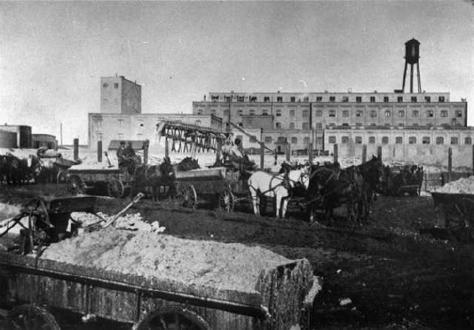
Photo: Denver Public Library, Western History Collection
More About This Topic
Many factories in Colorado turned field crops into food products. Most were located near small towns where farmers came to buy supplies and sell their crops. Among the largest were the sugar factories like the one in this photo. The beet pulp was hauled away to be used as cattle feed.
Their Own Words
"The Experiments with irrigation in the last quarter of the nineteenth century laid the basis for the introduction of new crops--grain, potatoes, and then the sugar beet. . . . One year during the early plowing two men arrived from the city. . . . [When these] visitors left . . . our father came into the house, with his team still in the field, to tell Mother of the new crop these men wished him to test out--the sugar beet. Nothing more important can happen to a farmer than to be offered a sure cash crop. . . . Here were these men from the city holding out this alluring prospect of a crop that would always be bought by the sugar company, and my father agreed to plant four acres."
"The occasion was momentous for my father and other farmers like him because it gave them a new status in the scheme of things. They were no longer appendages to the cattlemen, producers of winter fodder for the men who fattened steers for market, nor were they only subsistence families, supplying their own needs and a little over. They were tied now to the Great Western Sugar Company, and belonged to a commercial enterprise and the high destiny of their country."
Source: Clara Hilderman Ehrlich, "My Childhood on the Prairie," Colorado Magazine, 60 (2): 123-24.
Holly Sugar Factory
This photo shows the six-story brick buildings of the sugar refinery in Holly, Colorado. Holly is located in Prowers County, in the southeastern part of Colorado. The smoke from the tall chimney shows that the plant was operating. Notice that sugar beets are piled outside the factory. The location of the factory in Holly indicates that sugar beets were an important crop for farmers in many part of the Colorado plains. This photo was taken about 1900.
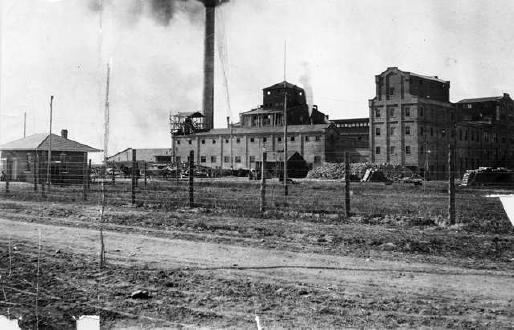
Photo: Denver Public Library, Western History Collection
More About This Topic
Sugar beet growing provided jobs for many people in Colorado. Farmers made money raising the beets. People in the towns worked in the sugar factories during the beet harvest season. The railroads made money shipping bags of sugar to eastern markets. Finally, the cattle raisers who bought the beet pulp made money from the cattle they fed and fattened.
Their Own Words
“Potatoes grew and yielded very well at that time. These gave way to sugar beets, which were introduced to this section [Weld County] late in the nineteenth century. My father was among the first to grow them. A factory for making beet sugar was first built at Loveland. A railroad was built around through the beet-growing section and beets were loaded onto cars at ‘dumps’ and hauled to the factory. The growing of sugar beets required a great deal of hand labor so our first immigrants were German-Russians from the Ukraine in Russia."
Source: Hazel Webb Dalziel, “The Way It Was,” Colorado Magazine, 45 (Spring 1968): 105.
Unloading Sugar Beets In Brighton
This photo shows farmers unloading sugar beets outside a sugar refinery in Brighton, Colorado. Two trucks are unloading sugar beets next to a machine that lifts them into tall piles for storage.
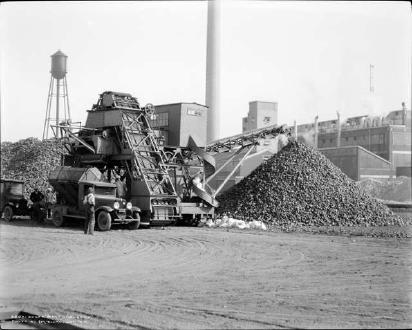
Photo: Denver Public Library, Western History Collection
More About This Topic
Sugar beets are usually harvested after the first frost in the fall. Most sugar beet farmers harvest their beets at about the same time. The beets are then stored near the factory to be used when needed in the refinery. This photo was probably taken about 1910.
Their Own Words
“[Farmers] would come in with their wagons, their trucks, weigh the trucks full, dump their [sugar] beets in a hopper. There was a funneled hopper. It had a belt, and it would take [the sugar beets] up to the top of the little house on the top where they would be screened. The beets would go out the side and drop into a railroad car. . . . Then all the dirt that was on ‘em would fall in another little hopper underneath this building, so when you dumped your beets you waited till they went up the belt, over the screen into the car, and then you pulled underneath this little building, pulled another lever and you got your dirt back. . . . All you were selling was the beets!”
Source: Charles Waneka quoted in Maria M. Rogers, ed., In Other Words: Oral Histories of the Colorado Frontier (Golden, CO: Fulcrum Publishing, 1996): 26.
Inside Greeley Sugar Factory
This photo shows factory workers standing among sugar beet presses. This factory was the Great Western sugar refinery in Greeley, Colorado. These presses were used to filter the sugar beet pulp and make it more pure.
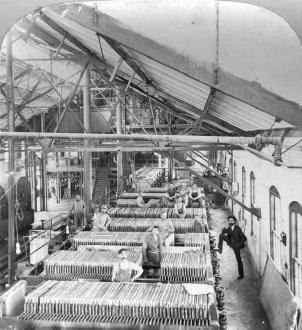
Photo: Denver Public Library, Western History Collection
More About This Topic
Notice the man in the suit with his leg up against one the the presses. He was probably one of the managers of the factory. This photo was taken about 1890.
Their Own Words
“’Bout all the farmers had to have a little cash crop to help pay for their places. That’s what my dad figured on. Beets. ‘Course he had milk cows but his cash crop to pay the interest on his payments . . . was beets. My Dad . . . claimed he’d never got the place paid for if he didn’t have beets. He even figured that he could make money by havin’ less hay and goin’ out and buy hay so he could have the cash crop from the beets to make his payments.”
Source: Elden Hodgson quoted in Maria M. Rogers, ed., In Other Words: Oral Histories of the Colorado Frontier (Golden, CO: Fulcrum Publishing, 1996): 26.
Kuner's Pickle Factory
This photo shows the Kuner Company Pickle plant in Brighton, Colorado. Brighton is in Adams County, just north of Denver. Notice that the factory building is of wooden frame construction. You may also see a water tower, a smokestack, and stacks of crates. The crates were used to carry the produce to the factory.
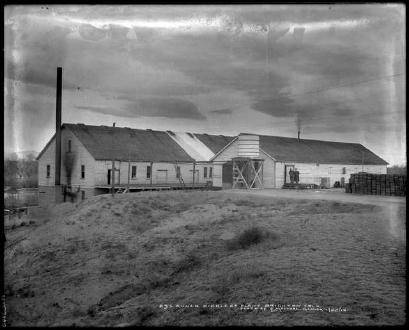
Photo: Denver Public Library, Western History Collection
More About This Topic
What kind of vegetable do you think farmers brought to this pickle factory? The Kuner Company canned all sorts of vegetables, which were raised by nearby farmers. This photo was taken in 1910.
Their Own Words
“My father, the late O. E. Frink, . . . my mother . . . and family moved from Denver to Fort Lupton in 1895. . . . In 1904, with his usual wisdom and courage, he decided to start a canning factory in connection with his creamery. The necessary additions to the creamery buildings were made, second hand canning machinery gathered from here and yon, together with such new machinery as was needed and father, with no experience, started the Silver State Canning and Produce Company."
Source: Marguerite Frink Counter, “Pioneer Canning Industry in Colorado,” Colorado Magazine, 30 (January 1953): 45-46.
Inside Kuner's Pickle Factory
This photo shows a part of the inside of the Kuner Company pickle plant in Brighton, Colorado. The men and women are processing cabbages. This photo was taken about 1912.
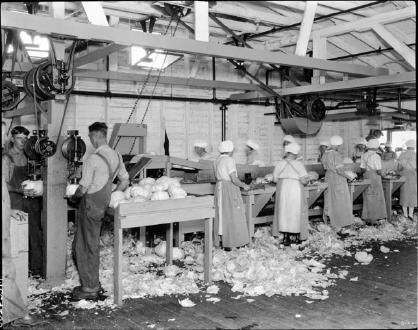
Photo: Denver Public Library, Western History Collection
More About This Topic
Many towns in the farming areas of Colorado had factories that processed food. They prepared pickles, sauerkraut, beans, and other vegetables, which were canned or sealed in glass jars.
Their Own Words
"[My father] canned tomatoes, catsup, and corn, adding gradually snap beans, peas, pickles, pumpkin, and squash. . . . The Silver State Canning and Produce Company grew like the proverbial Topsy. My father made many experiments in lima beans, asparagus, strawberries, spinach, and succotash. . . . Thus a small enterprise grew, expanded, and became of vital interest to the community—not only to the farmers but to the large number of town people to whom it gave employment.”
Source: Marguerite Frink Counter, “Pioneer Canning Industry in Colorado,” Colorado Magazine, 30 (January 1953): 46.
A Hygiene Creamery
This is a photo of a cheese factory at Hygiene, Colorado. The carts and wagons outside the factory are loaded with milk cans. This photo was taken about 1896.
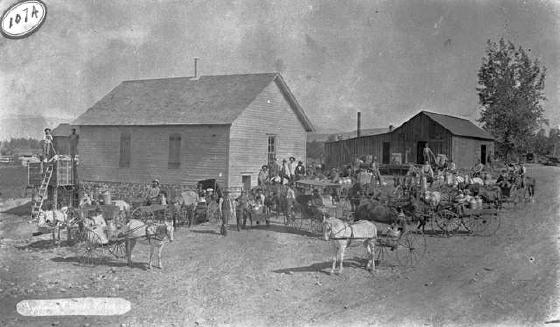
Photo: Denver Public Library, Western History Collection
More About This Topic
The farming areas of Colorado also had dairies and cheese factories. Farmers who owned cows made money by selling milk there.
Their Own Words
"It may surprise some to learn that there was once a cheese factory in Jefferson [in South Park]. It was formed by several of the ranchers, and the product was known as South Park Full Cream Cheese. Father also was agent for this company. He supervised production, shipping, and finances. The ranch members of the company supplied him with milk for the factory. A regular cheese maker was employed to run the factory. If I remember right, the factory started production in 1892. But something went wrong, and in about two years the factory folded up. The equipment was sold and shipped away."
Source: George W. Champion, "Remembrances of South Park," Colorado Magazine, 40 (January 1963): 19.

